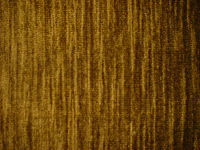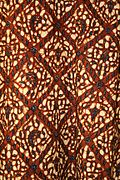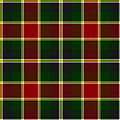- Chenille fabric
-
For other uses, see Chenille (disambiguation).
Chenille may refer to either a type of colored yarn or fabric made from it.
Chenille, the French word for caterpillar, is typically used to describe a type of fabric. Many fabrics, such as mohair and wool, get their names from the fibers with which they are made. Chenille, however, is named from the unique process by which it is made.
Contents
History
According to textile historians, chenille-type yarn was produced as far back as the 18th century. Back then the yarn was actually made by weaving a "leno" fabric and then cutting the fabric into strips to make the chenille yarn.
In the 1920s and 30s, Dalton in Northwest Georgia became the tufted bedspread capital of the US thanks to Catherine Evans (later adding Whitener) who initially revived the handcraft technique in the 1890s. Hand-tufted bedspreads with an embroidered appearance became increasingly popular and were referred to as "chenille" a term which stuck.[1] With effective marketing, chenille bedspreads appeared in city department stores and tufting subsequently became important to the economic development of North Georgia, maintaining families even through the Depression era.[1] Merchants organised "spread houses" where products tufted on farms were finished using heat washing to shrink and "set" the fabric. Trucks delivered pattern-stamped sheets and dyed chenille yarns to families for tufting before returning to pay the tufters and collect the spreads for finishing. By this time, tufters all over the state were creating not only bedspreads but pillow shams and mats and selling them by the highway.[1] The first to make a million dollars in the bedspread business, was Dalton County native, B. J. Bandy with the help of his wife, Dicksie Bradley Bandy, by the late 1930s, to be followed by many others.[1]
In the 1930s, usage for the tufted fabric became widely desirable for throws, mats, bedspreads, and carpets, but not as yet, apparel. Companies shifted handwork from the farms into factories for greater control and productivity, encouraged as they were to pursue centralized production by the wage and hour provisions of the National Recovery Administration's tufted bedspread code. With the trend towards mechanisation, adapted sewing machines were used to insert raised yarn tufts.[1]
Chenille became popularized for apparel again with commercial production in the 1970s.
Standards of industrial production were not introduced until the 1990s, when the Chenille International Manufacturers Association (CIMA) was formed with the mission to improve and develop the manufacturing processes.[citation needed] From the 70s each machine head made two chenille yarns straight onto bobbins, a machine could have over 100 spindles (50 heads). Giesse was one of the first major machine manufacturers. Chenille fabrics are also often used in Letterman jackets also known as "varsity jackets", for the letter patches.
Description
The chenille yarn is manufactured by placing short lengths of yarn, called the "pile", between two "core yarns" and then twisting the yarn together. The edges of these piles then stand at right angles from the yarn’s core, giving chenille both its softness and its characteristic look. Chenille will look different in one direction compared to another, as the fibres catch the light differently. Chenille can appear iridescent without actually using iridescent fibers. The yarn is commonly manufactured from cotton, but can also be made using acrylic, rayon and olefin.
Improvements
One of the problems with chenille yarns is that the tufts can work loose and create bare fabric. This was resolved by using a low melt nylon in the core of the yarn and then autoclaving (steaming) the hanks of yarn to set the pile in place.
In quilting
Since the late 1990s, chenille appeared in quilting in a number of yarns, yards or finishes. As a yarn, it is a soft, feathery synthetic that when stitched onto a backing fabric, gives a velvety appearance, also known as imitation or "faux chenille". Real chenille quilts are made using patches of chenille fabric in various patterns and colours, with or without "ragging" the seams.
The chenille effect by ragging the seams, has been adapted by quilters for a casual country look. A quilt with a so-called "chenille finish" is known as a "rag quilt" or, a "slash quilt" due to the frayed exposed seams of the patches and the method of achieving this. Layers of soft cotton are batted together in patches or blocks and sewn with wide, raw edges to the front. These edges are then cut, or slashed, to create a worn, soft, "chenille" effect.
Care
Many chenille fabrics should be dry cleaned. If hand or machine-washed, it should be machine-dried using low heat, or as a heavy textile, dried flat to avoid stretching, never hung.
References
External links
 Chisholm, Hugh, ed (1911). "Chenille". Encyclopædia Britannica (11th ed.). Cambridge University Press.
Chisholm, Hugh, ed (1911). "Chenille". Encyclopædia Britannica (11th ed.). Cambridge University Press.
Categories:- Pile fabrics
- Yarn
- Textile stubs
Wikimedia Foundation. 2010.





